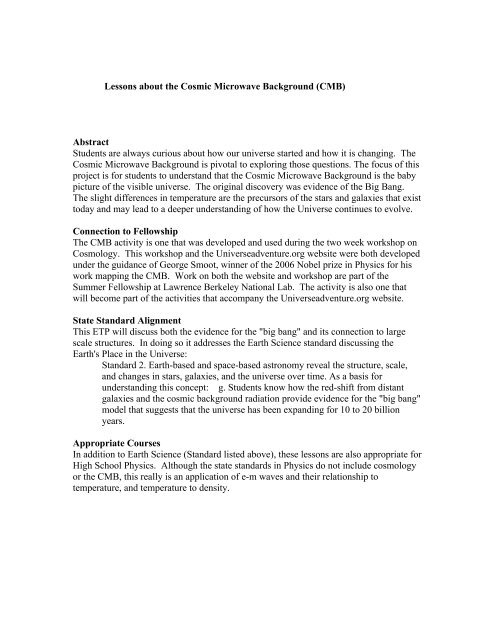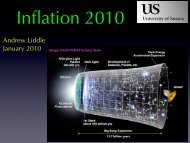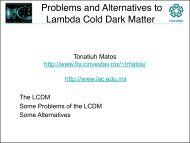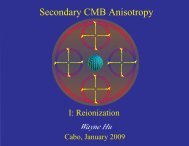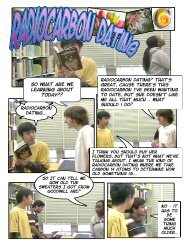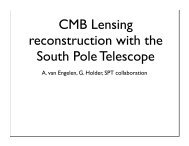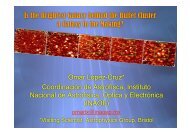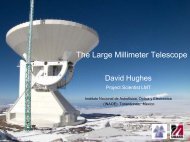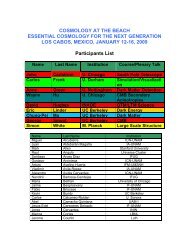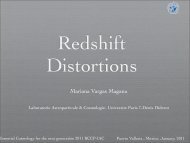CMB Coloring Worksheet - Berkeley Center for Cosmological Physics
CMB Coloring Worksheet - Berkeley Center for Cosmological Physics
CMB Coloring Worksheet - Berkeley Center for Cosmological Physics
Create successful ePaper yourself
Turn your PDF publications into a flip-book with our unique Google optimized e-Paper software.
Lessons about the Cosmic Microwave Background (<strong>CMB</strong>)<br />
Abstract<br />
Students are always curious about how our universe started and how it is changing. The<br />
Cosmic Microwave Background is pivotal to exploring those questions. The focus of this<br />
project is <strong>for</strong> students to understand that the Cosmic Microwave Background is the baby<br />
picture of the visible universe. The original discovery was evidence of the Big Bang.<br />
The slight differences in temperature are the precursors of the stars and galaxies that exist<br />
today and may lead to a deeper understanding of how the Universe continues to evolve.<br />
Connection to Fellowship<br />
The <strong>CMB</strong> activity is one that was developed and used during the two week workshop on<br />
Cosmology. This workshop and the Universeadventure.org website were both developed<br />
under the guidance of George Smoot, winner of the 2006 Nobel prize in <strong>Physics</strong> <strong>for</strong> his<br />
work mapping the <strong>CMB</strong>. Work on both the website and workshop are part of the<br />
Summer Fellowship at Lawrence <strong>Berkeley</strong> National Lab. The activity is also one that<br />
will become part of the activities that accompany the Universeadventure.org website.<br />
State Standard Alignment<br />
This ETP will discuss both the evidence <strong>for</strong> the "big bang" and its connection to large<br />
scale structures. In doing so it addresses the Earth Science standard discussing the<br />
Earth's Place in the Universe:<br />
Standard 2. Earth-based and space-based astronomy reveal the structure, scale,<br />
and changes in stars, galaxies, and the universe over time. As a basis <strong>for</strong><br />
understanding this concept: g. Students know how the red-shift from distant<br />
galaxies and the cosmic background radiation provide evidence <strong>for</strong> the "big bang"<br />
model that suggests that the universe has been expanding <strong>for</strong> 10 to 20 billion<br />
years.<br />
Appropriate Courses<br />
In addition to Earth Science (Standard listed above), these lessons are also appropriate <strong>for</strong><br />
High School <strong>Physics</strong>. Although the state standards in <strong>Physics</strong> do not include cosmology<br />
or the <strong>CMB</strong>, this really is an application of e-m waves and their relationship to<br />
temperature, and temperature to density.
Lesson Plan<br />
Lesson about the Cosmic Microwave Background (<strong>CMB</strong>)<br />
I. Content: Students will understand how the Cosmic Microwave Background is<br />
evidence of the Big Bang Theory. Students will understand that the slight variations in<br />
temperature are the seeds of the large scale structures that evolved over cosmic time.<br />
They will understand that a decrease in temperature causes an increase in density and<br />
that more dense areas have more gravity. These low temperature, high density, larger<br />
gravity regions are the starting points of structure <strong>for</strong>mation in the Universe.<br />
II. Prerequisites: Students should understand that density is mass / volume. Students<br />
should know that gravity increases with mass and decreases with distance. Students<br />
should understand that (except <strong>for</strong> water at 4 degrees C) as materials cool they become<br />
denser. Students should understand that the Universe started as a much smaller hot dense<br />
region that expanded outward in an event called the Big Bang.<br />
III.Instructional Objective: Students will be able to describe how the Cosmic Microwave<br />
Background is evidence of the Big Bang Theory and that the slight variations in<br />
temperature are the seeds of the large scale structures that evolved over cosmic time.<br />
They will be able to state the rule that decreasing temperature increases density and that<br />
more dense areas have larger gravity and there<strong>for</strong>e attract more matter. They will also<br />
be able to describe that these low temperature, high density areas in the <strong>CMB</strong> are the<br />
starting points of structure <strong>for</strong>mation in the Universe.<br />
IV. Instructional Procedures:<br />
1) Pass out Class Discussion Handout to accompany the review of concepts #2-7<br />
(see page 5).<br />
2) Review the concept of density. Remind students that density is mass / volume.<br />
3) Discuss the fact that as material cools down it becomes denser since its volume<br />
decreases. (If brought up remind students that water is the exception to this<br />
since it is most dense at 4 degrees C. That is why ice at 0 degrees C floats even<br />
though it is colder than liquid water.)<br />
4) Discuss the fact that everything with mass attracts everything else with mass<br />
and the greater the mass the greater the gravitational attraction.<br />
5) Remind students that scientific evidence supports the Big Bang Theory which<br />
states that the Universe started out as a very small hot dense area of energy that<br />
has over the last 13.7 billion years expanded and cooled into the stars, planets,<br />
and the galaxies we see today.<br />
6) Tell students that the <strong>CMB</strong> (Cosmic Microwave Background) is like a baby<br />
picture of our early Universe. It is evidence that supports the Big Bang Theory.<br />
7) Discuss that microwaves are a type of electromagnetic wave meaning they carry<br />
energy just like visible light. They are the waves that carry energy that cook<br />
food in microwave ovens. Microwaves are longer wavelengths than visible<br />
light. Cosmic Microwaves are the energy that spread out from the Big Bang.
8) Have students color in the <strong>CMB</strong> coloring page (see page 8). This will help<br />
them see the variations in the <strong>CMB</strong>. These variations are what lead to galaxies<br />
such as our own Milky Way, and clusters of galaxies. Different colors can be<br />
substituted but remember that blue light is higher energy than red light.<br />
Students<br />
could also design their own way to designate the differences using one color.<br />
9) Have students go to the http://www.Universeadventure.org website:<br />
(Smoot, George, et al.<br />
The Universe Adventure<br />
Lawrence <strong>Berkeley</strong> National Laboratory.<br />
Copyright © 2005 Lawrence <strong>Berkeley</strong> National Laboratory <strong>Physics</strong> Division |<br />
Last Update: August 2, 2007<br />
http://www.universeadventure.org)<br />
Once at the site have them go to the section labeled Evidence <strong>for</strong> the Big Bang.<br />
In that section have them go through the pages labeled Cosmic Microwave<br />
Background Accidental Discovery and Origins of the <strong>CMB</strong>. If students do not<br />
have computers you could assign reading from their text or copy the included<br />
text from those pages from the website (see pages 13-18). For students that<br />
need a guided questions to answer while going through the website or reading<br />
have them complete the Website Questions handout (see pages 6-7).<br />
10) Then have students complete the Understanding the Cosmic Microwave<br />
Background sheet (see page 9). A comment on question 4: you may wish to<br />
skip this if you don’t have access to the website since the text version doesn’t<br />
show this part. Also, this may be too detailed if students don’t have an<br />
understanding of red-shift.<br />
11) Discuss the correct answers. Answer keys on pages 11-12.<br />
V. Materials and Equipment:<br />
colored crayons or pencils<br />
copy machine or printer to duplicate the worksheets<br />
colored one <strong>for</strong> #4 on the Understanding <strong>CMB</strong><br />
<strong>CMB</strong> coloring page can be done without a color copier,<br />
just list the colors in the key<br />
internet access *(one computer <strong>for</strong> every two to three students)<br />
or copy attached text (pages 13-18)<br />
or assign appropriate pages from class text<br />
*The internet pages do contain animations that help clarify the concepts.
VI. Assessment/ Evaluation:<br />
Give the following quiz (see page 10 <strong>for</strong> handout copy):<br />
1) When something is cooled it becomes: a) more dense b) less dense .<br />
2) As mass increases gravity? a) increases b) decreases c) remains constant.<br />
3) The Cosmic Microwave Background is important because:<br />
a) it cooks my food, b) is evidence of the Big Bang, c) has neat colors<br />
4) More dense areas have: a) less gravity so matter collect there b) more<br />
gravity so matter collects there c) no gravity so matter collects there.<br />
5) Colder regions in the <strong>CMB</strong> are: a) areas were no matter exists b) areas that<br />
are less dense so matter collects, c) areas were matter collects due to<br />
increased density, d) are more dense areas were matter can’t collect.<br />
6) The starting points in the Universe <strong>for</strong> structures such as stars are:<br />
a) cold, dense, high gravity regions, b) warm, dense, low gravity<br />
regions, c) cold, low density, low graivty regions.<br />
VII. Follow-up Activities:<br />
1) Have students write a paragraph describing how the slight variations in the<br />
temperatures in the <strong>CMB</strong> lead to large scale structure <strong>for</strong>mation.<br />
2) Have students make a flip book showing structure <strong>for</strong>mation.<br />
3) Go through other sections of the Universeadventure.org website. Such as<br />
in the section on Evidence <strong>for</strong> the Big Bang go through the pages on<br />
Red-shift then complete the Rubber Band activity accessed through<br />
the teacher section on the title page of the website. This will help<br />
students understand the expansion of the Universe.<br />
4) Explore more of the Universeadventure.org website and the teaching<br />
materials there to learn more about the Big Bang and the History of our<br />
Universe.<br />
5) For highly motivated students they could read Wrinkles in Time by George<br />
Smoot and report back to the class.<br />
VIII. <strong>Worksheet</strong>s, Answer Keys, and Copy of Website pages.<br />
Class Discussion <strong>Worksheet</strong><br />
Website Questions<br />
<strong>CMB</strong> <strong>Coloring</strong> Page<br />
Understanding the Cosmic Microwave Background<br />
Quiz<br />
Answer Keys<br />
Copy of Website pages
Class Discussion - Student <strong>Worksheet</strong><br />
1) The equation <strong>for</strong> density is:<br />
NAME __________________________<br />
2) An example of something<br />
a) more dense than water is b) less dense than water<br />
3) In my own words density means:<br />
4) As things cool down their size (volume) ________________ so they become<br />
_______________dense.<br />
5) Everything with matter will _____________everything else with matter.<br />
6) In my own words gravity means:<br />
7) List ways to increase gravity.<br />
8) What is the Big Bang Theory?<br />
9) What evidence is there to support this theory?<br />
10) What is a wave?<br />
11) What type of wave are Cosmic Microwaves?
NAME____________________________<br />
Website Questions to go with the reading from Universedaventure.org.<br />
1) What was the accidental discovery of Penzias and Wilson?<br />
2) Why was this discovery important to Astrophysics?<br />
3) How long after the Big Bang was the <strong>CMB</strong> <strong>for</strong>med?<br />
4) What were the conditions of the early Universe at the time the <strong>CMB</strong> <strong>for</strong>med?<br />
5) What is the temperature of the <strong>CMB</strong> now?<br />
6) What made the Universe cool down as demonstrated in the <strong>CMB</strong>?<br />
7) What do the differences in color in the <strong>CMB</strong> represent?<br />
8) The light from the <strong>CMB</strong> really came from a process called decoupling in which<br />
__________________ separated from _________________. This separation<br />
occurred because the Universe __________________which cooled the Universe
enough that ______________could <strong>for</strong>m when electrons bond to nuclei.<br />
9) The original light was at a temperature of _______K (________degrees F).<br />
Sketch what happened to the wavelengths of light as the temperature cooled due<br />
to the expansion of the Universe.<br />
Hotter - - - - - - - - - - - - - - - - Cooler<br />
10) This stretching of wavelengths is called the _______________ because red<br />
wavelengths of light are longer than yellow or green or blue.<br />
11) The age of the Universe is ______________________.<br />
12) The anisotropies on the <strong>CMB</strong> represent tiny ______________ in ____________<br />
which are really fluctuations (changes) in ______________________.<br />
13) The colder areas are more dense and denser areas have more ______________ so<br />
they can attract more matter leading to the <strong>for</strong>mation of ___________________.<br />
14) Explain why the <strong>CMB</strong> and maps of the Earth are shaped like ovals.<br />
15) Why is the <strong>CMB</strong> so important?<br />
16) Why are the anisotropies so significant?
Understanding the Cosmic Microwave Background<br />
1.a) When did the <strong>CMB</strong> occur?<br />
b) What is the Cosmic Microwave Background?<br />
c) What significant event happened in cosmic history to produce the <strong>CMB</strong>?<br />
2. How do temperature & density relate—why?<br />
3. Although the discovery that the <strong>CMB</strong> is virtually the same temperature<br />
everywhere was significant, the slight variations in temperature are now<br />
of great interest—why? What do these “wrinkles in time” have to do<br />
with the history of the universe?<br />
4. Below are some other pictures of the <strong>CMB</strong>. Why do they appear so<br />
different from the one you colored? What are the differences?
<strong>CMB</strong> Quiz Name_______________________<br />
Date__________________<br />
1) When something is cooled it becomes: a) more dense b) less dense.<br />
2) As mass increases gravity? a) increases b) decreases c) remains constant.<br />
3) The Cosmic Microwave Background is important because:<br />
a) it cooks my food b) is evidence of the Big Bang c) has neat colors<br />
4) More dense areas have:<br />
a) less gravity so matter collect there<br />
b) more gravity so matter collects there<br />
c) no gravity so matter collects there<br />
5) Colder regions in the <strong>CMB</strong> are:<br />
a) areas were no matter exists<br />
b) areas that are less dense so matter collects<br />
c) areas were matter collects due to increased density<br />
d) are more dense areas were matter can’t collect<br />
6) The starting points in the Universe <strong>for</strong> structures such as stars are:<br />
a) cold, dense, high gravity regions<br />
b) warm, dense, low gravity regions<br />
c) cold, low density, low graivty regions.
Answers to Student <strong>Worksheet</strong> – Class Discussion<br />
1) Density = Mass / Volume<br />
2) a) cement, books, most rocks b) Styrofoam, oil, beach ball, air<br />
3) Density is how much matter (stuff) is per space.<br />
4) Decreases (shrinks), more<br />
5) Attract<br />
6) Gravity is the attraction (or pull) that everything has on everything else.<br />
7) You can increase gravity by increasing mass or bringing things closer together.<br />
8) The Big Bang Theory states that the Universe was once a smaller more dense<br />
hotter area that has expanded over time.<br />
9) The evidence to support this theory is the Cosmic Microwave Background.<br />
(Other evidence not specifically addressed in this lesson include: a) expansion of<br />
the Universe b) elemental abundances c) evolution of stars and galaxies. Thee are<br />
discussed in further detail in other website pages.)<br />
10) A wave is a transfer of energy.<br />
11) Cosmic Microwaves are a type of electromagnetic wave. (These include visible<br />
light.)<br />
Answers to Website Questions<br />
1) Penzias and Wilson discovered microwave radiation (<strong>CMB</strong>) coming from all<br />
directions from space.<br />
2) This discovery was important to Astrophysics because it supplied evidence <strong>for</strong> the<br />
Big Bang Theory.<br />
3) The <strong>CMB</strong> was <strong>for</strong>med about 380,000 years after the Big Bang.<br />
4) The early Universe was hot and dense.<br />
5) The <strong>CMB</strong> is 2.7 K now.<br />
6) The Universe and the expanded which caused the energy to spread out as shown<br />
in the waves stretching.<br />
7) The differences in the colors of the <strong>CMB</strong> represent small differences in<br />
temperature.<br />
8) Matter, light, expanded, atoms.<br />
9) 3000 K, (5000 F)<br />
hotter should be small wavelengths, cooler should be longer wavelengths<br />
10) Red-shift<br />
11) 14 billion years (14.7)<br />
12) variations (differences), temperature, density.<br />
13) Gravity, stars and galaxies.<br />
14) These maps are shaped like ovals because it is the way to represent a sphere on a<br />
flat piece of paper.<br />
15) The <strong>CMB</strong> is so important because it is evidence that supports the Big Bang.<br />
16) Anisotropies are significant because these slight differences are the seeds of star<br />
and galaxy <strong>for</strong>mation.
Answers to the Understanding the Cosmic Microwave Background worksheet:<br />
1) The <strong>CMB</strong> is the Cosmic Microwave Background. It is the baby picture of the<br />
early Universe since it is the waves that spread out from the Big Bang. The Big<br />
Bang occurred 13.7 billion years ago.<br />
2) As temperature decreases substances become more dense (except <strong>for</strong> water at 4<br />
degrees C.) Decreasing temperature makes objects decrease in volume. Since<br />
density is mass/ volume, if the volume decreases the density increases.<br />
3) The slight variations in temperature lead to areas that are denser and these colder<br />
more dense regions have a slightly larger gravity so they collect more matter<br />
leading to large-scale structures such as stars.<br />
4) The first picture demonstrates the <strong>CMB</strong> be<strong>for</strong>e the effect of the direction of<br />
motion is removed. When moving towards light the light appears blue shifted as<br />
seen in the lower left, when moving away the light is red shifted as seen in the top<br />
right.<br />
The second picture still shows the light from the Milky Way (our galaxy) which<br />
we look through to see the <strong>CMB</strong>.<br />
Answers to the quiz<br />
1- a<br />
2-a<br />
3-b<br />
4-b<br />
5-c<br />
6-a
Smoot, George, et al.<br />
The Universe Adventure<br />
Lawrence <strong>Berkeley</strong> National Laboratory.<br />
Copyright © 2005 Lawrence <strong>Berkeley</strong> National Laboratory <strong>Physics</strong><br />
Division | Last Update: August 2, 2007<br />
http://www.universeadventure.org<br />
The Universe Adventure<br />
Cosmic Microwave Background Radiation<br />
"Once you eliminate the impossible, whatever is left, no matter how improbable, it must<br />
be the truth." -Sir Arthur Conan Doyle, Sherlock Holmes<br />
Accidental Discovery<br />
In 1964, Bell Laboratory scientists Arno Penzias and Robert Wilson were trying to detect<br />
sources of radiation that might potentially harm satellites. Their data, however, showed<br />
background noise from a microwave signal corresponding to a temperature of<br />
approximately 2.7 K that appeared to be emitted from every direction. This apparent<br />
aberration was recognized by scientists at Princeton as remnant radiation from the earliest<br />
observable moment in the evolution of the universe, now called the Cosmic Microwave<br />
Background.<br />
Arno Penzias and Robert Wilson with the Horn Antenna used to discover the Cosmic<br />
Microwave Background.<br />
Their discovery was a tremendous one <strong>for</strong> astrophysics, providing a glimpse of the<br />
earliest observable moment in the evolution of the Universe.
What is the <strong>CMB</strong>?<br />
The Cosmic Microwave Background, or <strong>CMB</strong>, is ancient radiation leftover from a time<br />
roughly 380,000 years after the Big Bang when the hot, dense plasma that permeated the<br />
Universe cooled with the expansion of space. At a nearly uni<strong>for</strong>m temperature of 2.7<br />
Kelvin, the <strong>CMB</strong> fills the entire Universe and can be detected everywhere we look. If the<br />
human eye could see microwaves, the entire sky would glow with nearly equal brightness<br />
in every direction.<br />
A map of the Cosmic Microwave Background. The different spots of color correspond to<br />
different temperatures and in turn, different densities.<br />
Here are some questions about the <strong>CMB</strong> that we will answer in this section:<br />
• Where did it come from?<br />
• Why is it so cold?<br />
• Why is the map different colors?<br />
• Why is the map of the <strong>CMB</strong> an oval?
The Universe Adventure<br />
Origins of the <strong>CMB</strong><br />
The first light radiated after decoupling is now known as the <strong>CMB</strong>.<br />
During the first 380,000 years after the Big Bang, the universe was so hot that all matter<br />
existed as plasma. During this time, photons could not travel undisturbed through the<br />
plasma; instead, the photons constantly interacted with the charged electrons and<br />
baryons. This is a phenomenon known as Thompson Scattering. As a result, the universe<br />
was opaque. As the universe expanded and cooled, electrons began to bind to nuclei,<br />
<strong>for</strong>ming atoms. The introduction of neutral matter allowed light to pass freely without<br />
scattering. This separation of light and matter is known as decoupling.<br />
The light first radiated from this process is what we now see as the Cosmic Microwave<br />
Background. Similarly, in the video below, the precipitate in a solution of magnesium<br />
hydroxide scatters light from a flashlight, making it opaque to radiation.<br />
Movie: The Last Scattering | Download<br />
Why is the <strong>CMB</strong> so Cold?<br />
Light from the <strong>CMB</strong> was red shifted as the universe expanded, cooling it over time.
The <strong>CMB</strong> is a perfect example of red shift. Originally, light from the <strong>CMB</strong> had a much<br />
shorter wavelength corresponding to a temperature of about 3,000 K (nearly 5,000° F).<br />
As the universe expanded, the light was stretched into longer and longer wavelengths.<br />
By the time the light reaches us, 14 billion years later, we observe it as microwaves at a<br />
frigid 2.7 K (-450° F). This is why <strong>CMB</strong> is so cold now.<br />
What do the Colors on the <strong>CMB</strong> Map Represent?<br />
Although the temperature of the <strong>CMB</strong> is almost completely uni<strong>for</strong>m at 2.7° K, there are<br />
very tiny variations, or anisotropies, in the temperature on the order of 10 -5 K. The<br />
anisotropies appear on the map as cooler blue and warmer red patches. But what do these<br />
minute fluctuations mean?<br />
Map of the <strong>CMB</strong> created from data gathered by the Wilkinson Microwave Anisotropy<br />
Probe (WMAP).<br />
These anisotropies in the temperature map correspond to areas of various density<br />
fluctuations in the early universe. Eventually, gravity would draw these fluctuations into<br />
even denser ones. After billions of years, these minute ripples in the early universe<br />
evolved, through gravitational attraction, into the planets, stars, galaxies, and clusters of<br />
galaxies that we see today.
Why are Maps of the <strong>CMB</strong> Shaped like Ovals?<br />
The spherical map of the <strong>CMB</strong> translates to an oval in the same way a globe translates to<br />
a familiar oval map when flattened.<br />
The <strong>CMB</strong> is shaped like an oval <strong>for</strong> the same reason that many maps of the world are<br />
ovals. You can't take a sphere and make it flat without tearing it, because a sphere is<br />
fatter in the middle than at the top and bottom.<br />
To see why this is true, peel and orange and try to flatten it. The only way you can<br />
accomplish this is by tearing the peel, or distorting it. Instead of "tearing" the map of the<br />
<strong>CMB</strong>, it is depicted as an oval, which is the shape with the least angular distortion of the<br />
original sphere.
The Predictive Power of the <strong>CMB</strong><br />
In 1992, physicists used the orbiting COBE satellite to make the first detailed<br />
measurements of the <strong>CMB</strong> anisotropy.<br />
The <strong>CMB</strong> is one of the strongest pieces of evidence <strong>for</strong> the Big Bang model. The theory<br />
makes highly accurate predictions about the size and types of anisotropies in the <strong>CMB</strong> as<br />
well as its nearly perfect black body spectrum, all of which have been verified by<br />
experiment and observation. The discovery of the <strong>CMB</strong> in the 1960's marked the end <strong>for</strong><br />
several competing cosmological models including the Steady State theory.<br />
With the in<strong>for</strong>mation attained from the <strong>CMB</strong>, we can understand the <strong>for</strong>mation of the<br />
structure and matter of the universe.


